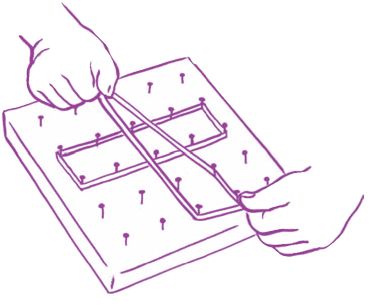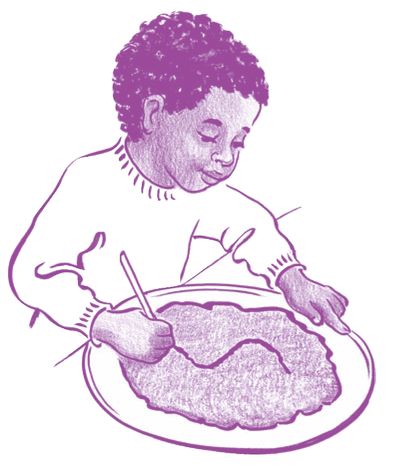Everyday Play (9 page)
Authors: Christy Isbell

Dynamic Tripod grasp
Enjoy this year of growth with your five-year-old. Help her expand her fine motor skills by doing the activities in this chapter, and watch her skills improve even further during her kindergarten year!
GeoboardsDevelops your child’s finger strength, bilateral coordination,
and in-hand manipulation skills
What You Needand in-hand manipulation skills
Geoboard—can be commercially purchased or handmade (see More Fun! below) | rubber bands with good elasticity in a variety of sizes
What to Do• Invite your child to explore the Geoboard and rubber bands.
• Demonstrate the method of stretching a rubber band from one peg to the next. Form lines, shapes, or letters with the rubber bands.
• Encourage your child to make her own lines, shapes, or letters on the Geoboard with rubber bands.

• Make a Geoboard. To make a Geoboard, you will need the following: square piece of wood (approximately 5” x 5”) | sandpaper | 25 finishing nails (1”) | ruler | hammer
To make your own Geoboard, go to a building supply store and ask someone to cut a square piece of wood. Sand the edges until smooth. Use a hammer to insert 25 finishing nails into the wood in an evenly spaced pattern of five rows with five nails each 1” apart. To allow room for the rubber bands, nails should extend ½” out from the surface of the wood.
Refines your child’s hand movements necessary for writing, develops good eye-hand coordination, and helps him use an age-appropriate grasp of writing utensil
What You NeedLarge-grid (at least ¼”) graph paper (may be printed for free off the Internet) | colored pencils
What to Do• Give your child a piece of graph paper and colored pencils.
• Encourage him to color in the squares to create “Graph Paper Art.”
• Form letters by coloring in squares of the graph paper. Draw a letter on the graph paper and then see if your child can copy it.
• Give him graph paper and watercolors or tempera paint and small paintbrushes with which he can explore painting squares or other shapes and designs.
Develops your child’s small muscle control and improves her eye-hand coordination
What You Needlarge sheets of paper | paper plates | various small toy vehicles, such as cars, trucks, vans, or construction vehicles | fingerpaint or tempera paint and markers | bowl of water | sponges or small brushes | paper towel
What to Do• Write your child’s name on a large sheet of paper. Use bubble-type letters that are large enough to serve as a track for small vehicles.
• Pour paint onto paper plates, and put some vehicles on the table.
• Encourage your child to experiment with making tracks by rolling a vehicle through the paint and then rolling the vehicle over paper.
• Show your child her “Name Track.” Invite her to roll a vehicle through the paint and trace the letters of her name with the vehicle to “make tracks.”
• When your child begins to lose interest in the activity, give her a bowl of water and small sponges or brushes to wash off the vehicles. Set them on a paper towel to dry.
• Some children may be able to make their name tracks independently, without having to follow the letter outlines.
• Provide blank sheets of paper and encourage your child to make new letter tracks on her paper.
Develops your child’s eye-hand coordination and helps him learn how to form letters of the alphabet
What You Needcraft sticks | scissors (adult-use only) | glue (squeezable or stick) | construction paper | washable markers
What to Do• Cut several craft sticks crosswise into halves and fourths (adult-only step). After cutting them, sand any rough edges.
• Write capital letters on the paper so that your child has an example to copy.
• Give your child various sizes of craft sticks, and encourage him to make “stick letters” by arranging the pieces of craft sticks on the construction paper.
Note
: Letters with curves will be more challenging to make, but encourage him to try to use small pieces of craft sticks to form them.
Note
: Letters with curves will be more challenging to make, but encourage him to try to use small pieces of craft sticks to form them.
• He can glue his letters to the construction paper, and then give them time to dry.
• Once the glue is dry, he can use markers to trace around his “stick letters” on paper or decorate the letters.
• Use sticks to write names or words that are interesting to your child.
• Your child may need you to write the letters on his paper so he can place the craft sticks directly on the lines.
Develops your child’s scissor skills, and strengthens her
eye-hand coordination
What You Needeye-hand coordination
thin, 8 ½” X 11” copying paper in various colors | child-safe scissors (sharp enough to cut thin paper) | chenille sticks
What to Do• After your child selects the paper for her flowers, help her use the scissors to cut the paper in half to form an 8 ½ x 5 ½ rectangle.
• Demonstrate how to accordion-pleat the paper, starting on the long side of the paper. Help her as needed.
• Ask her to hold the pleated paper while you help her wind one end of a chenille stick around the center of the paper.
• She can separate layers of the paper by gently pulling the paper apart at the edges of the flower.
• Place the flowers into a piece of Styrofoam and then inside the “Painted Flower Pot” (see Painted Flower Pots on page 116) for a beautiful gift or decoration.

Develops your child’s eye-hand coordination and his ability to move individual fingers (finger isolation)
What You NeedNo materials needed
What to Do• Sing the song “Where Is Thumbkin?” and demonstrate the related hand movements as you go.
• Show your child how to hold his fingers down to help isolate one finger for movement.
Note
: The middle and ring fingers are typically the hardest to isolate and individualize. Your child may need to hold down the other fingers until he masters this new motor pattern.
: The middle and ring fingers are typically the hardest to isolate and individualize. Your child may need to hold down the other fingers until he masters this new motor pattern.
• “This Old Man” is another good fingerplay that gives your child the opportunity to develop his isolated finger-movement skills as he displays each number (For example, “This Old Man, He played 1” (and so on).
Helps your child establish an effective grasp of writing tools and builds her finger strength
What You Needsmall cookie sheet or pizza pan | modeling clay (single color works best) |
stylus
(a wooden or metal tool used to make indentations in clay (available at craft stores). Make your own stylus by using a pen with the ink barrel removed or a chopstick
What to Dostylus
(a wooden or metal tool used to make indentations in clay (available at craft stores). Make your own stylus by using a pen with the ink barrel removed or a chopstick
• Invite your child to help you spread modeling clay evenly over the cookie sheet, so that the clay is ¼” or ½” thick.
• Show her the stylus and explain that it is a tool that artists use to make marks in clay.
• Show her how to use the stylus to write letters or draw shapes on the “Clay Writing Board.” Demonstrate how she can use her fingers to “erase” the letters in the clay by tracing them with her index finger and pressing the clay into its original flat shape.
• Encourage her to write her name, letters, or shapes in the clay. If necessary, help her by writing the letters first and then letting her trace over them with the stylus.

Improves your child’s grasp strength
What You Needcotton swabs | tempera paints | shallow containers for paints | paper (no larger than 8 ½” x 11”) | easel or wall for attaching paper
What to Do• Place the paper on an easel or tape it to a wall.
• Encourage your child to use cotton swabs as paintbrushes to create a picture.
• Give him a very small piece of paper to create mini artwork using the cotton swabs. A 3” x 5” index card works well.
Helps your child establish an appropriate
grasp of writing tools
What You Needgrasp of writing tools
golf pencils or small pencils that are less than 3” in length | pieces of crayons less than 3” in length | storage containers for pencils and crayons
What to Do• Label storage containers for golf pencils and pieces of crayons as “Itsy Bitsy.”
• Give your child “Itsy Bitsy” pencils and crayons for writing and drawing.
• Encourage her to use the “Itsy Bitsy” writing utensils in different activities.
• Provide small pieces of chalk for the child to practice writing and drawing on sidewalks or chalk boards.
• Read a book or tell a story about a small person or animal who was “Itsy Bitsy.” One favorite is “The Itsy Bitsy Spider.”
Increases your child’s finger strength and improves his grasp of tools and utensils
What You Needcontainers of water for filling eyedropper | eyedropper or
pipette
| pennies and quarters | newspaper or plastic to protect table from water spills
What to Dopipette
| pennies and quarters | newspaper or plastic to protect table from water spills
• Show your child how to fill up an eyedropper with water. Then, show him how to squeeze it gently to make drips of water.
• Give him a penny and a quarter. Ask him to predict how many drops of water each coin will hold.
• Ask him to drip water slowly onto the face of each coin to see how many water drops each coin can hold. Help him count, if necessary.
• Compare results by asking questions, such as, “How many water drops did the penny hold?” “How much did the quarter hold?” “Which coin held more water drops?” “Why?”
• Add a few drops of dishwashing liquid to the water container. Repeat the experiment. The dishwashing liquid reduces the surface tension of the water so the coins will not hold water drops.
Develops your child’s eye-hand coordination and in-hand manipulation skills
What You Needvariety of coins, including pennies, nickels, and quarters | small bowls or plastic containers for coins | paper | black pen or marker
Other books
Why Shoot a Butler by Georgette Heyer
Each Time We Love by Shirlee Busbee
Father Unknown by Lesley Pearse
Icing on the Cake by RaeLynn Blue
Wade and the Scorpion's Claw by Tony Abbott
Marianna by Nancy Buckingham
La paja en el ojo de Dios by Jerry Pournelle & Larry Niven
Mr. CEO by Willow Winters
June Bride: Now and Forever Romance by Regina Duke
Bride Games: (Alien's Bride) by Yamila Abraham
